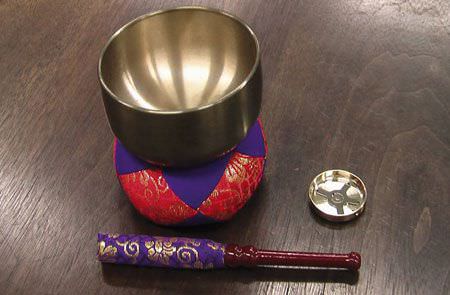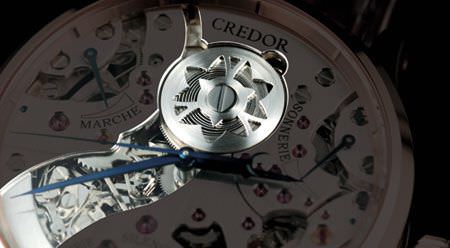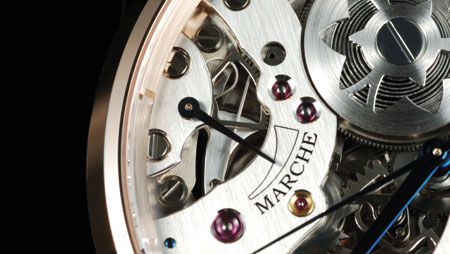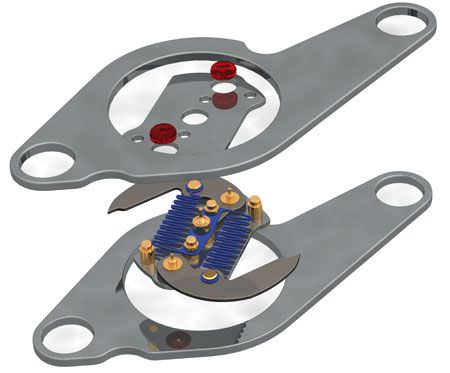One of the greatest delights of Seiko’s watchmakers regarding their Spring Drive movement is that not only is it especially silent, but also that the glide motion of its hands, which never jerk or jump, perfectly symbolizes the continuous, regular, and uninterrupted passage of time. So, if the Spring Drive visually displays the flow of time in this way, how does it express it acoustically, in this same calm and serene manner with its unique ‘sonnerie’?
A Buddhist inspiration
The answer to this question was, in fact, derived from the same cultural roots as those of Seiko’s watchmakers, who were inspired by the bells hanging in Buddhist temples. Employed since 300 B.C, the sound of these bells is especially pure and precise with a long and mellow tone quality, perfectly evoking a form of serenity linked to the continuous flow of time.
(Just as a side note, the bells in Buddhist temples did not serve the same function as the bells in occidental churches. When the church rang its bells, it was to dictate its own time and therefore regulate the rhythm of life in a given society. In Japan, on the contrary, it was the communities themselves that asked the temple to ring the bells at certain intervals, which could vary according to the seasons and the work in their societies.)
But, back to Seiko… To miniaturize a Buddhist bell in order to insert it into a watch movement was obviously not an easy task. To do so, Seiko worked in collaboration with a family of bell makers located in the centre of Japan, whose art dates back to the 17th century. They were able to develop a special alloy, whose secret is carefully kept by them, and not even known to Seiko. It was necessary to not only miniaturize the bell but, as it happened, to give it a completely different shape so that it would fit inside a watch. In the end, the ‘bell’ in question took the form of a sort of plate that occupies the back of the case of the Credor Spring Drive Sonnerie.

Orin Bell on left and, on right, the gong made out of the same alloy
Activation by the viscosity of the air
And, on a second point, Seiko’s watchmakers – in this case, eight specialists from the ‘Micro Artist Studio’ team whom Seiko asked to develop the project – had to succeed in activating the chime in a way that would not make a noise, since the Spring Drive itself operates silently. Because it did not contain a traditional escapement (for more about the Spring Drive movement and its Tri-Synchro Re-gulator, see Europa Star issue April/May 2006), Seiko’s watchmakers wanted to eliminate all the contact points of the chime’s mechanism so that it would operate completely quietly. With this precise goal in mind, they succeeded in developing a particularly ingenious system that makes up the heart of the chime’s mechanism. This moderator, or ‘governor’ uses the centrifugal force of two strips which, when rotating rapidly (300 revolutions per second), move away from each other, thus producing a ‘current’ of air. This current, by the simple viscosity of the air that is produced, activates the ‘sonnerie’ without any mechanical contact.
An interval of about 10 seconds separates the activation of the system from the first ‘strike’ on the bell. This interval is necessary so that, after the hour-rack acts on the lever, the centrifugal force governor increases in energy until the rotational speed necessary for it to act is reached. If the interval between the strikes was less, the winding time would be shorter, but an interval of about three seconds between the strikes allows the resonating sound to linger until the next strike occurs. This pronounced interval between the different strikes not only permits the ear to appreciate the quality of the sound, but also offers a very Buddhist feeling of serenity and calm. The hours that are chimed (the Credor Spring Drive Sonnerie only sounds the hours) are culturally very different from the hours chimed by a traditional repeater, which, in comparison, seems to be ‘panicked’ by the time.

Three modes
The quality of the sound’s resonance is improved by four small openings in the case back. But the movement, while it is not guaranteed to be water-resistant, is nonetheless protected from the moisture and dust by a filter.
The chiming mechanism, which has its own independent barrel offering a power reserve of 40 hours (indicator at 2 o’clock on the dial), can be set to three different modes. The ‘sonnerie’ mode chimes each hour, for the number of hours that have passed. The ‘Original’ mode chimes three times at every third hour – 12 o’clock, 3 o’clock, 6 o’clock, and 9 o’clock. There is also the ‘Silence’ mode where the chime is disengaged.
Movement ‘Japanese style’
The ‘Japaneseness’ of the Credor Spring Drive Sonnerie goes beyond the particularity of its unique chime. It also has an effect on the movement and its decoration. On the face of the dial, the mainspring barrel of the bell mechanism can be seen under the cut-out design of a flower that is symbolic of Japan. This ‘Kikyo’ flower is placed at the top of an opening that is in the form of a river, as if it were drifting down, representing the flow of time. Made up of more than 600 component parts, this movement is very well finished and required nearly seven months of work to final completion, including assembly by the watchmaking team at the Micro Artist Studio.

Hammer

Governor
Strategic rise in strength
Strategically, this exceptional piece, of which only five will be made per year selling at prices of around 108,000 euros, marks the rise in strength of Seiko in the haut de gamme sector of timekeeping. Until now, the brand’s most prestigious achievements were reserved uniquely for the Japanese market. With the launch last year of the Spring Drive collection, Seiko plans to move onto the terrain that has previously been reserved for Swiss watch brands.
The strong ‘ring’ made by the Credor Spring Drive Sonnerie during BaselWorld does, in fact, open a new era, of which this remarkable timekeeper is only the beginning. What is especially encouraging is that the Japanese have taken a totally new, and even cultural, approach to their creations, rather than seeking to compete using the same-old practices. The development of watchmaking in its entirety can only find itself invigorated and stronger because of it.
Source: Europa Star August-September 2006 Magazine Issue








